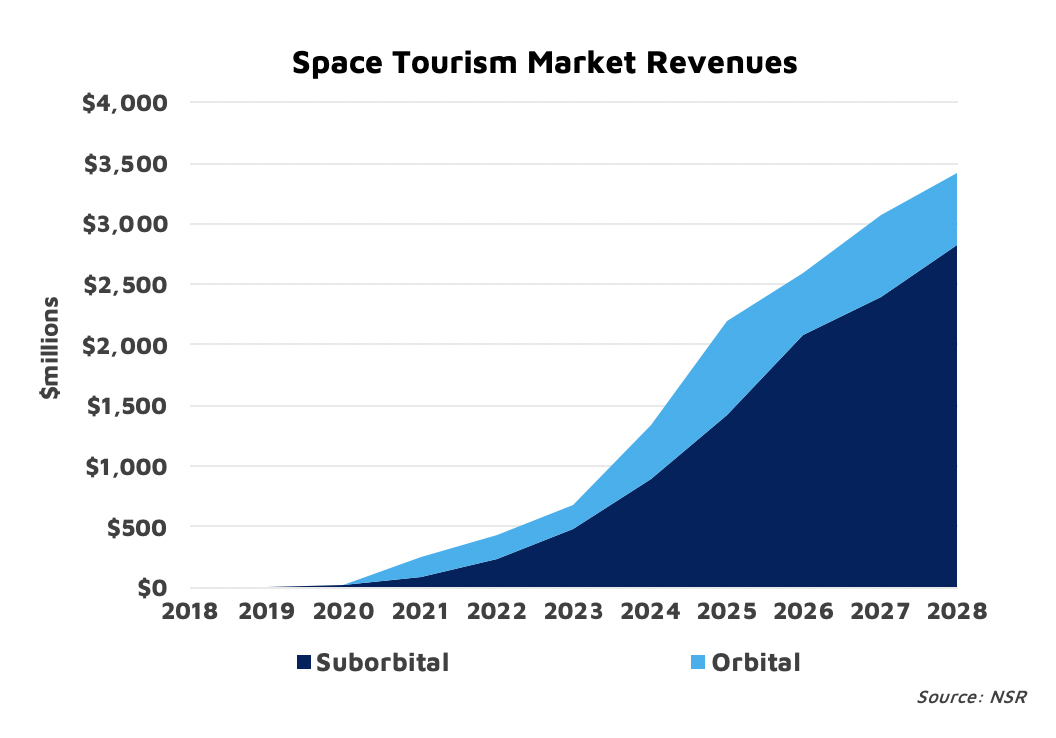Space Tourism: Humanity Leaving the Cradle?
As technology development accelerates at an ever-increasing speed, reaching new milestones that will arguably lead to putting commercial tourists in space this year, governments across the world are considering strategic long-term plans to establish a lasting human presence off-Earth. Space tourism is largely seen as a stepping stone in the long-term development roadmap for off-Earth exploration activities; it is simultaneously a byproduct and a direct beneficiary of the strategic plans being put into place. The vastly different growth opportunities for both subsets of space tourism are as important to consider as their most recent technology milestones, as they help set expectations to prepare for what is coming next.

NSR’s industry-first Space Tourism and Travel Markets (STTM) report expects suborbital and orbital tourism services to begin in 2020 and 2021, respectively, with demand for both rising to new heights, creating an attractive opportunity of $14B in cumulative commercial revenues by the end of 2028. SpaceX and Space Adventures’ latest partnership announcement confirms NSR’s timeline, with an orbital commercial tourist mission to the ISS planned for 2021. Because development in space tourism is seen as an interim step to establishing a stronger industrial presence off-world, NSR’s STT report establishes baseline conditions that are prerequisite for growth to beyond-LEO destinations such as the Moon and Mars.
NASA’s current goal is to return to the Moon by 2024, establishing sustainable exploration efforts there by 2028, all part of an effort to prepare for Mars. To that end, it is no surprise that NASA’s plans include the repurposing of current in-space assets, such as NASA’s effort to commercialize the International Space Station (ISS) by 2024, which would in turn work to create a type of low-Earth orbit economy, while allowing reallocation of resources to focus on the Moon-to-Mars roadmap.
Commercial orbital space tourism opportunity via the ISS is just one of the proposed uses in repurposing the space station, an opportunity that Axiom Space is leaning into. Most recently, NASA selected Axiom Space to provide the first commercial module to be attached to the ISS through a public-private partnership. Under this program, Axiom Space will be able to test its technology and have a chance to prove its orbital tourism business case, while using the ISS as its cradle. Other players like SpaceX are also planning to take advantage of the ISS-for-tourism opportunity, signing onto a mission with long-time space tourism broker Space Adventures. Because demand for orbital tourism is severely constrained by lack of affordability, and NSR does not expect the price tag to decrease significantly by end of 2028, growth potential in this vertical is limited. Conversely, commercial suborbital spaceflight services are associated with significantly lower prices, positioning players like Virgin Galactic and Blue Origin to take advantage of short-term demand.
The Bottom Line
The space innovation machine keeps churning, energized by seemingly tremendous demand and largely untapped potential of off-Earth exploration, which has been deemed impossible to date but seems well within technological reach now. Market conditions have improved to help aid the development of off-Earth capabilities, but there is still a heavy dose of uncertainty facing the reality of sustainable business models for space tourism. Off-world ventures still remain tethered to government support, which is highly influenced by budgetary cycles and fluctuation in public priorities. As we understand today, significant opportunities do exist, but much remains largely uncertain. Even though space tourism opportunities to other planets are still far from being viable, current commercial players can reduce risk and benefit the most out of their business cases by aligning their future growth strategies with governments’ strategic plans. And in the process, help humanity make small steps in leaving the cradle of Earth.
